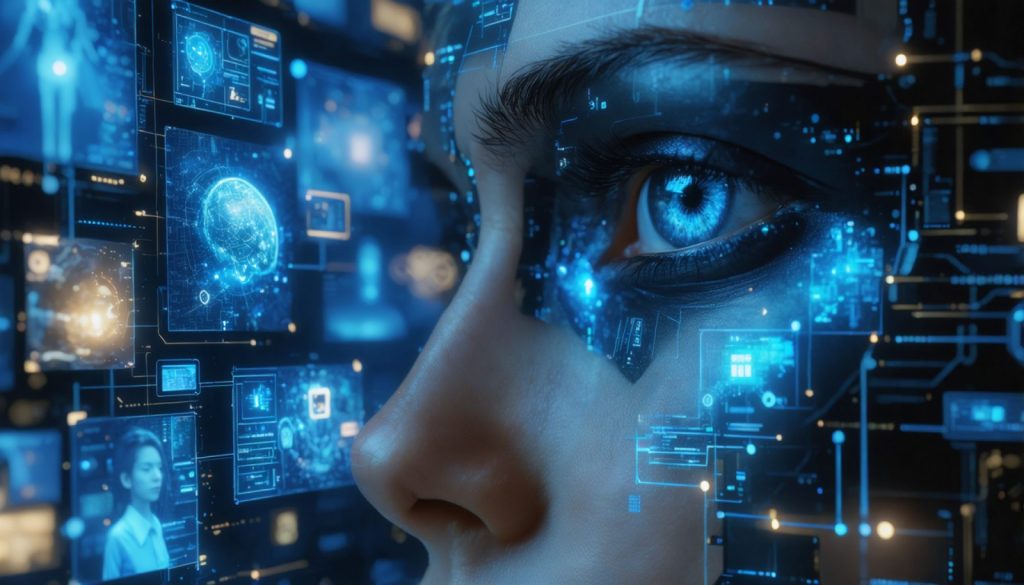
- Pau Aleikum Garcia, a media designer, explores the intersection of technology and humanity with his project on synthetic memories.
- His use of generative AI helps refugees and survivors reconstruct lost visual moments, blending empathy with digital innovation.
- Garcia’s studio collaborates globally with entities like the United Nations, transforming data into powerful artistic narratives.
- Synthetic memories redefine storytelling, using AI to create emotional connections and foster resilience and healing.
- Garcia’s work challenges the conventional role of AI, positioning it as a partner in crafting empathetic narratives.
- His insights advocate for ethical and humane technology applications that enhance communication without losing humanity.
- The “Digital Disruption” podcast episode offers valuable insights for those interested in AI and innovative storytelling methods.
In a world awash with data, meaning often gets lost in the noise of numbers and algorithms. Enter Pau Aleikum Garcia, a visionary media designer, who stands at the intriguing crossroads of technology and humanity. Garcia’s groundbreaking project on “synthetic memories” is turning heads, offering an innovative way to breathe life into lost visual moments through the power of generative AI.
On the latest episode of the “Digital Disruption” podcast by Info-Tech Research Group, listeners are drawn into a conversation that challenges the conventional boundaries of AI. Together with host Geoff Nielson, Garcia delves into how his project helps refugees and survivors reclaim stolen fragments of their past using artificially recreated images and sounds. But this isn’t just about technology—it’s about crafting empathy in a digital era.
Garcia’s Barcelona-based studio, with its global footprint spanning over 45 countries, collaborates with monumental entities like the United Nations and Citizen Lab. His repertoire of work transforms data into thoughtful artistic narratives, igniting action and introspection. The project illuminates paths where technology not only reconstructs memories but also stitches them into powerful emotional tapestries that resonate with human resilience and healing.
Listeners learn that in the age where attention is fractured, the storytelling landscape is ripe for transformation. Garcia’s synthetic memories offer more than reconstructed visuals; they challenge us to engage with AI as a partner in empathy, fundamentally redefining how stories are told. This technological artistry is about making the intangible palpable, turning the past into something one can almost touch and feel again.
The conversation extends beyond mere data points, exploring the essence of “info experiences”—dynamic presentations that breathe life into numbers, creating emotional connections that inspire action. It’s a journey to bridge the gap between data’s cold precision and the warmth of human experience.
Garcia, also an educator and founder of HeyHuman!, initiates dialogues that merge data, music, and social justice, advocating for the ethical and humane application of technology. His insights reveal a future where AI and design blend harmoniously to reshape how institutions communicate, offering clarity without sacrificing humanity.
With synthetic memories, Garcia demonstrates that AI has the remarkable potential to make our digital world more, not less, human. It’s a profound reminder that technology, when wielded with purpose, can reconnect us with our identities and shared histories, paving the way for a more interconnected storytelling future.
Explore this gripping episode on “Digital Disruption” via YouTube, Apple Music, or Spotify. Professionals eager to stay at the forefront of digital innovation and storytelling will find a trove of insights ready to transform how they perceive and utilize data in their realms.
Discovering Synthetic Memories: How AI Breathes Life into Lost Moments
Pau Aleikum Garcia: Pioneering AI with Empathy
In an era overflowing with data, finding meaning amidst the noise of numbers and algorithms is an evolving challenge. However, Pau Aleikum Garcia, a visionary media designer, bridges this gap by using generative AI to create “synthetic memories,” a project that breathes life into lost visual moments. Inspired by humanitarian needs, Garcia’s work focuses on assisting refugees and survivors in reclaiming stolen fragments of their past through artificially recreated images and sounds, thereby infusing empathy into digital innovation.
How Synthetic Memories Work
Garcia’s project utilizes generative AI technology to recreate visual and auditory memories from scant information. The technology works by analyzing available data—be it incomplete images or fragmented sounds—and reconstructing them into cohesive, emotionally resonant experiences. Such AI-generated content allows for the rebuilding of past moments, enabling individuals to reconnect with their histories in profoundly personal ways.
Real-World Applications and Trends
1. Humanitarian Impact: Synthetic memories have immense potential in humanitarian efforts. By helping refugees and survivors visualize their lost pasts, the technology supports emotional healing and identity reconstruction.
2. Cultural Preservation: AI can become a pivotal tool in preserving cultural heritage by reconstructing artifacts or events that lack complete historical records.
3. Media and Storytelling: The media industry can leverage these AI capabilities to offer immersive storytelling experiences, transforming abstract data into emotional narratives that engage audiences.
Pros and Cons Overview
Pros:
– Emotional Healing: Offers therapeutic benefits for trauma recovery by reconstructing lost memories.
– Cultural Impact: Assists in the preservation and revitalization of cultural heritage.
– Enhanced Storytelling: Brings a new dimension to visual and auditory storytelling, facilitating deeper emotional connections with audiences.
Cons:
– Ethical Concerns: Raising issues regarding the authenticity and manipulation of memories.
– Technology Dependence: High reliance on advanced AI and data for accurate reconstruction.
– Privacy Risks: Possibility of misuse of personal data in creating synthetic memories.
Industry Trends and Future Predictions
The intersection of AI and storytelling continues to evolve, with institutions increasingly utilizing this technology to merge analytical data with human-centric narratives. Garcia’s work illustrates a broader industry trend toward using AI not just as a tool of efficiency, but as a medium for empathy and connection.
Expert Opinions and Credibility
Garcia’s collaboration with global organizations like the United Nations and Citizen Lab reflects the broad acceptance and credibility his initiatives command. The ethical and humane application of technology in his projects demonstrates a commitment to responsible innovation.
Actionable Recommendations
For professionals wishing to stay at the forefront of digital innovation and empathy-driven AI applications:
– Stay Informed: Regularly explore podcasts like “Digital Disruption” to gain insights into cutting-edge technological trends.
– Engage with Communities: Join forums and discussions that focus on AI in media and humanitarian applications.
– Invest in Learning: Consider workshops or courses on AI and digital empathy to understand its applications and implications fully.
For further exploration into the intersection of AI, media, and storytelling, consider visiting Info-Tech Research Group for more resources and insights into the latest technological advancements.
By embracing technology’s empathetic potential, professionals and creators can redefine how stories are told, fostering a future where data and humanity coexist harmoniously.



